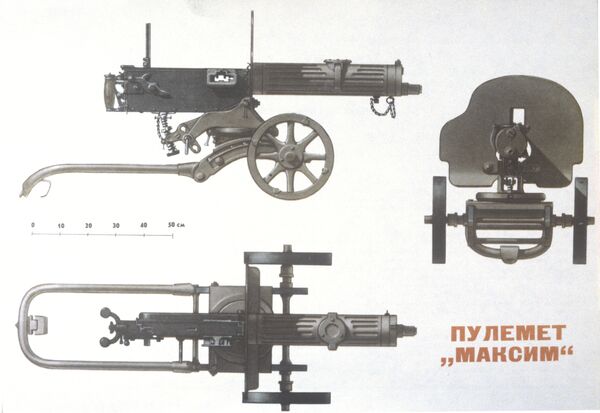Sir Hiram Stevens Maxim was born in America on February 5, 1840, emigrated to Britain 1881 and adopted British citizenship in 1899. Over his long career, Maxim is credited with over a thousand different inventions and received patents for 270 of them. He also designed a steam-fuelled aircraft, was named a Chevalier of the Legion of Honor, and claimed to have invented the light bulb.
Nevertheless, Maxim is mostly remembered as the inventor of the Maxim gun, the first portable, fully automatic machine gun.
Maxim, however, did not invent the very first machine gun as a rapid-fire weapon, which was actually invented by Dr. Richard Gatling in 1861 in the United States. The Gatling gun was hand-cranked device that consisted of six barrels revolving around a central shaft. Although imperfect, it was used in the militaries of the United States and several other countries for many years.
Moreover, the first automatic weapons that made use of the recoil from a fired projectile to reload were invented long before Maxim's time. In 1854, English engineer Henry Bessemer received a patent for an automatic, breech-loading gun that used steam-power to feed, lock and fire the weapon. The bullet or shell was inserted or loaded at the rear of the barrel, or breech. Nine years after that, a fully automatic machine gun was patented in the United States. But both Bessemer's gun and the American fully automatic weapon were relegated to the sidelines, because manufacturing was not yet sophisticated enough to produce them. The two inventions remained mere technical marvels in the memory of their contemporaries.
Maxim initially presented his invention to the United States Department of War in 1883, even though he had emigrated to Britain in 1881. However, the American military saw the gun as little more than an amusing curiosity.
Afterwards, Maxim returned to Britain, where he founded the Maxim Gun Company to produce his machine gun. He then was able to demonstrate his invention to powerful figures in many countries, including German Kaiser Wilhelm, who insisted that several Maxim guns should be bought for the German army, and Russian Emperor Alexander III.
The Maxim machine gun was initially used to protect artillery systems from enemy attacks and defend military fortifications. However, its subsequent use in battle forced the military to reassess their approach to the weapon.
It is unclear when the Maxim gun was used first. Some scholars say that it was in Africa in 1893, during the British conflict with the Zulu. Others say it happened several years later, during the Boxer Rebellion in China.
The deadly power of the Maxim gun was first officially recorded during the Battle of Omdurman (1898), when an army of 8,000 British and 17,000 Egyptian troops commanded by General Sir Herbert Kitchener repelled an attack by 50,000 Sudanese rebels. Kitchener lost only 100 men, while the rebels lost about 20,000, 15,000 of whom were felled by machinegun fire.
This made it clear that the new weapon allowed a relatively small group of soldiers to repel attacks from a more numerous enemy effectively.
Machine guns won their rightful place on the battlefield during World War I, when commanders agreed that the weapons should be moved from the artillery to the infantry units and ordered more of them. This changed war tactics dramatically, as one machine gun was as effective as 15 rifles.
Nevertheless, the weapon's significant size meant that it was mainly used to defend against massive infantry and cavalry attacks, which were effectively stopped by machine gun cross fire. The machine gun as a defensive weapon thus proved more effective than any offensive systems at the time.
But while the combatants fired tons of artillery shells at each other from protected positions, designers in Germany, Britain, France and Russia were working on new weapons capable of breaking through the enemy's echeloned defenses. Toxic gases, flamethrowers, tanks and assault groups were their answers to Sir Hiram's invention.
In other words, the machine gun as a death machine was indirectly responsible for spurring the arms race.
MOSCOW. (RIA Novosti economic commentator Vlad Grinkevich)
The opinions expressed in this article are the author's and do not necessarily represent those of RIA Novosti.




